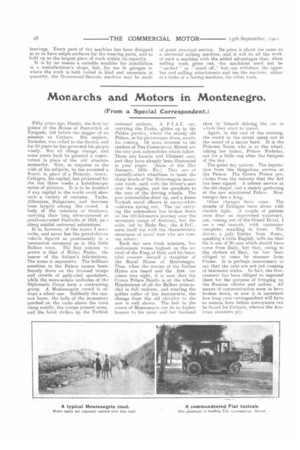Monarchs and Motors in Montenegro.
Page 6

If you've noticed an error in this article please click here to report it so we can fix it.
(From a Special Correspondent.)
Fifty years ago, Danilo, the first lay prince of the House Of Petrovitch of Nyegush, fell before the dagger of an assassin at Cattaro. His nephew, Nicholas, was called to the throne, and for 50 years he has governed his people wisely. But all things change, and some years back he granted a constitution in place of the old absolute monarchy. Now, in response to the wish of his subjects, he has accepted a Royal, in place of a Princely, crown. Cettigne, his capital, has presented for the last three weeks a kaleidoscopic series of pictures. It is to be doubted if any capital in the world could show such a variety of costume. Turks, Albanians, Bulgarians, and Servians loom largely among the crowd. A body of the veterans of Grahowo, carrying their long silver-covered or pearl-encrusted flintlocks of 1858, pas s along amidst universal salutations.
It is, however, of the motcr I must write, and never has the petrol-driven vehicle figured so prominently in a coronation ceremony as in this little Balkan town. The first mission to arrive is that of Hilmy Pasha, the bearer of the Sultan's felicitations. The scene is impressive. The brilliant sunshine in the Palace square beats fiercely down on the bronzed troops and crowds of gaily-clad spectators, while the more-sedate uniforms of the Diplomatic Corps form a contrasting group. A Montenegrin crowd is always a silent one. Suddenly the cannon boom, the bells of the monastery perched on the rocks above the town clang noisily, the troops present arms, and -the band strikes up the Turkish
national anthem. A FIAT. car, carrying the Pasha, glides up to the Palace portico, where the sturdy old Prince, in his picturesque dress, awaits
his ss Of more interest to the readers oTKE COMMERCIAL MOTOR are the two post automobiles which follow. These are Laurin and Clement cars, and they have already been illustrated in your pages. [Issue of the 21st January, 1909.En.] They are of specially-short wheelbase to meet the sharp bends of the Montenegrin mountain roads, each with the driver's seat over the engine, and the sprockets to the rear of the driving wheels. The post automobiles draw up, and a dozen Turkish naval officers in snowy-white uniforms spring out. The car carrying the commodore has broken down on the 100-kilometre journey over the mountain range of Antivari, but the suite, led by Hafiz Bey, the A.D.C., sorts itself out with the characteristic smartness of naval men who are corning ashore.
Each day sees fresh missions, but enthusiasm waxes highest on the arrival of the King of Italy and his beautiful consort—herself a daughter of the Royal House of Montenegro. Then, when the strains of the Italian Hymn are .heard and the first car comes into sight, it is seen that the Crown Prince Danihi is at the wheel. Handsomest of.all the Balkan princes, clad in full uniform, and wearing the golden collar of the Annunciata, the change from the old chivalry to the new is well shewn. The heir to the crown of Montenegro can do no higher honour to his sister and her husband than by himself driving the car in o Melt they elect to travel.
Again, in the cool of the evening, the crowd in the street opens out at the sound of a motor horn. It is the Princess Xenia who is at the wheel, taking her father, Prince Nicholas, out for a little run after the fatigues of the day.
The great day arrives. The deputation from the Skupehina arrives at the Palace. The Crown Prince proclaims from the balcony that the Act has been signed. A solemn service at the old chapel. and a stately gathering at the new ministerial Palace. Montenegro has a king.
Other changes have come. The streets of Cettigne have shone with electric light. A couple of patient oxen draw an improvised watercart, yet, coining out of the Grand Hotel, I see a real taxicab, with taximeter complete, standing in front. The driver, a jolly Italian from Rome, speaking a little English, tells me that his is one of 20 ears which should have come from Italy, but that, owing to the cholera at Ban, he has been obliged to come by steamer from Fiume. It is perhaps unnecessary to say that the cabs are not yet running at. taximeter scales. In fact, the Government has been obliged to impound them for the purpose of bringing up the Russian officers and sailors. All means of communication seem to have broken down, so now it is uncertain how long your correspondent will have to remain here before conveyance can he found for Cattaro, whence the Austrian steamers ply.
























